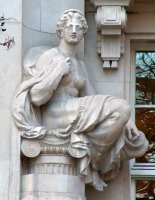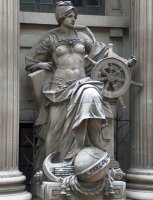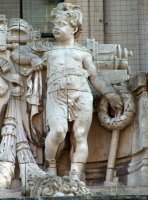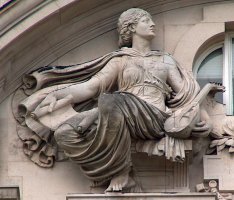Albert Hodge (1875-1918)
Typical female figure by Albert Hodge.
Albert Hodge is known for his statues with exaggerated muscles, particularly noticeable in his female figures. He has a range of significant public works and architectural sculpture in England, Scotland and Wales.
The work of the sculptor Albert Hodge appears around the turn of the century, and his output continues up to his unfortunately early death in his 40s. He was born on the Isle of Islay, trained as an architect, found a penchant in working on architectural details, and this led to him becoming a sculptor - his main works are indeed architectural sculpture.
His work is solid, monumental, with lots of detail. His figures tend to the very muscular, with the women buxom. Even when Hodge (rarely) aims for feminine pulchritude, he accentuates the muscles of the arms, legs and neck. Drapes, where present, are often stretched, flying, or if hanging, highly undercut for effects of light and shade, and to emphasise the 3D quality of his work.
Navigation, Port of London Authority.
In London, his largest pieces are those for the former Port of London Authority, no. 10 Trinity Square, near the Tower of London, a massive Edwardian pile with a blocky tower. Very high up and central above the oversized Corinthian portico is a giant statue of Neptune or Father Thames, a biblical nude figure with trident. To left and right, figure groups of Produce and Exportation, rather difficult to view from ground level. Sculpted by Hodge, these were executed by Charles Doman from 1912-1922.
On the front of 99 Aldwych (see this page) is good figural sculpture male and female nudes in stone on the pediment, draped bronze figures recessed at first floor level, and putti over the side. With the exception of the bronze figures, these are all by Hodge.
Hodge has further work nearby - the pair of stone allegorical figures for 4 Millbank, opposite Victoria Tower Gardens by the Houses of Parliament. Again, the musculature is extraordinary, the raised arm of the female figure that of a wrestler. 5 minutes away, in Great George Street, Hodge was apparently also the creator of the putti and coat of arms over the main entrance of the Institute of Civil Engineers, a slight work. And another comparable example of his modelling of the infant body is in Regent's Park. It is called The Lost Boy, a hideous cherub astride a vulture with the solidarity favoured by Hodge, though this is not unusual for a cherub. He showed similar other things at the Royal Academy astride a goat and a turkey but I do not know where these ended up.
On the front of the V&A towards Exhibition Road, Hodge is responsible for two of the portrait statues, to Wedgewood and Chippendale. Can we reconcile these with the athletes he made elsewhere? Only the heavy calves of Chippendale give a clue.
Female figure, Music, by Hodge.
In Cardiff, Hodge has three enormous groups in the Cathays Park precinct. Two are in front of the Cardiff Mid-Glamorgan County Hall, and represent Mining and Navigation - see this page. The overall effect is excellent, but the individual parts lack somewhat the sense of effort by the figures is clear, and the Greek drapery is good, but the expressions on the faces vary from the contorted to the bland. The third group is one of those on Cardiff City Hall itself, an impossibly muscular Britannia with seahorses and soldiers left and right, at the rear.
In Glasgow, Hodge's are the crouching nude figures on the Caldedonian Chambers, 75-93 Union Street, dating from 1903, and a Queen Victoria for the Glasgow Royal (Victoria) Infirmary. Other works in the city include allegorical sculpture for the Clydeport Building, 16 Robertson Street, and angels etc for 752 Argyle Street.
His only other outdoor statues I am aware of are the Captain Scott Memorial, Mount Wise, Devonport, with a big Valkyrie-like angel behind the subject, the Robert Burns memorial behind Dumbarton Road in Stirling (thank you to Amy Waugh for noting this one), and he also carved relief panels for the city of Hull, which I have not seen. Abroad, he produced pediment sculpture for the Parliament Buildings in Winnipeg, Canada; picture below. It is a poor picture, but if you click to enlarge you can make out the muscular female and male figures, and equally Schwarzeneggian animals.
We may mention in passing that Hodge also exhibited panels in relief, of some variation in his treatment of the female nude, heavy in the thigh and with over-developed biceps, but otherwise displaying more femininity in torso and breast than his figures in the round.
I would end by saying that although commenting on the extreme musculature in Hodge's figures, this is in no way to belittle his work, which is anatomically careful, inventive in pose and interesting in subject. And he seems to have exerted some profound influence over Doman, his assistant. Hodge's architectural sculpture, on the enormous Port of London, and the solid Cardiff City Hall figures, manage to avoid being dwarfed or made pointless by the scale of the buildings, which has brought many a sculptor to grief, and in this he must be commended. In a modern world where female bodybuilders can disturb us with their bulk and distance from maybe more conventional versions of the feminine ideal, and after many years of increasingly stylistic sculpture, perhaps Hodge is more at home today than many of the sculptors of the 19th and early 20th Century.
Visits to this page since 22 Nov 2011: 8,148




